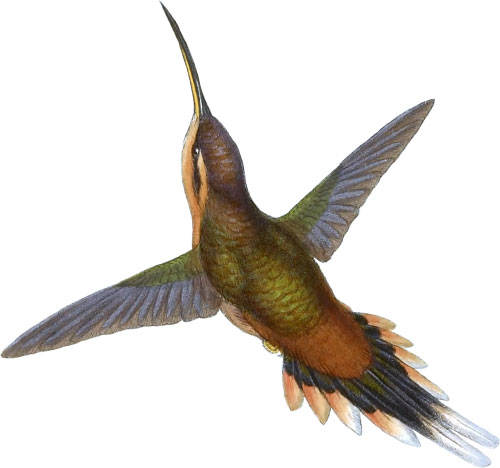Little Hermit
Northern Brazil, Bahia, the banks of the Lower Amazon
This species must not be confounded with the Trochilus pygmæus of Spix or the Trochilus rufigaster of Vieillot; from the former it differs in being of a larger size, in the buff of the under surface being of a lighter and purer hue, in the black mark on the chest being smaller and less conspicuous, and in the more cuneate form of the tail, all the feathers of which are largely tipped and edged with buff; while from Vieillot’s bird, if his description and figure be correct, it differs in the two middle tail-feathers being less developed, and in their tips being buff instead of white.
Lesson’s description of the bird which he has considered to be identical with Vieillot’s T. rufigaster applies to the present species with the greatest accuracy, but the figure which accompanies the description neither agrees with it nor with any other bird with which I am acquainted; the black marks beneath the eye and on the chest, although so well described, are not indicated, and the feet, which are said to be yellow, are figured of a dark brown. The T. pygmæus of Spix, which is so accurately described and figured that it cannot be mistaken for the bird here represented, is a native of the northern parts of Brazil; the T. rufigaster is said to be from Cayenne; and the present bird, so far as J am aware, is confined to Southern Brazil; the numerous specimens in my collection are all from the Amazon and Bahia.
The nest, as will be seen, is ingeniously attached with spiders’-webs to the extremity of a leaf of a Dicotyledonous plant, and is composed of various fine silky and cottony vegetable fibres mixed with spider’s web and portions of a fungus (?) resembling wool; in form it is round, deep, cup-shaped, and tapers to a lengthened point at the bottom. ‘The nest figured is in my own collection, and I also possess another containing two eggs, procured by Mr. Hawkswell at Buena Vista in June 1848.
The eggs are two in number, of a pinky white, about seven-sixteenths of an inch in length by about fivesixteenths in breadth.
The male has the bill black, except the basal two-thirds of the lower mandible which is yellow; crown of the head, back of the neck, back and shoulders bronzy green, the green predominating on the latter; stripe over and behind the eye and all the under surface, except a few white feathers on the lower part of the abdomen, deep buff; ear-coverts and a tuft of feathers on the chest black; rump and upper tail-coverts reddish buff; tail bronzy brown with green reflexions, all the feathers tipped with buff, which colour becomes rather paler on the tips of the two centre ones; wings deep purplish brown; outer side of tarsi clothed with short buffy brown feathers; feet and inner part of tarsi yellow; claws dark brown; eyes blackish brown.
Total length, 3\(\frac{1}{2}\) inches; bill, 1\(\frac{1}{16}\); wing, 1\(\frac{3}{8}\); tail, 1\(\frac{3}{8}\); tarsus, \(\frac{3}{16}\).
The female is similar in colour to the male, but is smaller in size.
The figures represent a male and a female of the natural size.
 Phaëthornis Longuemareus
Longuemare’s Hermit
Phaëthornis Longuemareus
Longuemare’s Hermit
 Phaëthornis Amaura
Amaura Hermit
Phaëthornis Amaura
Amaura Hermit
 Phaëthornis viridicaudata
Green-tailed Hermit
Phaëthornis viridicaudata
Green-tailed Hermit
 Paëthornis zonura
Southern Hermit
Paëthornis zonura
Southern Hermit
 Phaëthornis Adolphi
Adolph’s Hermit
Phaëthornis Adolphi
Adolph’s Hermit
 Phæthornis griseogularis
Grey-throated Hermit
Phæthornis griseogularis
Grey-throated Hermit
 Phaëthornis striigularis
Stripe-throated Hermit
Phaëthornis striigularis
Stripe-throated Hermit
 Phaëthornis obscura
Obscure Hermit
Phaëthornis obscura
Obscure Hermit
 Phaëthornis nigricinctus
Belted Hermit
Phaëthornis nigricinctus
Belted Hermit
 Phaëthornis Episcopus
Bishop Hermit
Phaëthornis Episcopus
Bishop Hermit
 Phaëthornis pygmæus
Pigmy Hermit
Phaëthornis pygmæus
Pigmy Hermit
Featuring all 422 illustrated species from John Gould’s A Monograph of the Trochilidæ, or Family of Humming-Birds arranged by color.